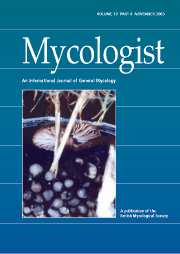No CrossRef data available.
Article contents
Penicillium claviforme - an impressive mould with an M. C. Cooke connection
Published online by Cambridge University Press: 24 December 2004
Extract
This handsome species of Penicillium (Fig 1) is widely used in mycology teaching as a fine example of a coremiform mould. It readily grows on commonly available laboratory media, such as malt extract and Czapek Dox agars, producing large white to pink stalked coremia which are positively phototropic.
Placed by Raper & Thom (1949) in their Asymmetrica-Fasciculata these authors comment that it “ - is not common in nature for few original isolations have been reported.” Pitt (1979) placed the majority of species of the Asymmetrica into the more formal subgenus Penicillium but placed P. claviforme and related species into the subgenus Biverticillium on the basis of his assessment of the fine structure of the phialides. However, work by Frisvad & Filtenborg (1983) and Logrieco, Peterson & Wicklow (1990) confirmed that it should remain in the subgenus Penicillium. It is interesting that Pitt also comments that the species is rare!
Unfortunately for those whose memory for names was established many decades ago the well known name Penicillium claviforme Bainier established in 1905 had to give way to an older specific epithet, Penicillium vulpinum (Cooke & Massee) Seifert & Samson, and it is judged that there is no case for conserving the name P. claviforme, however deeply engrained it has become in the literature (Frisvad et al., 1990). The name P. vulpinum arose through a study by Seifert & Samson (1985) on the type specimens of species originally attributed to the genus Coremium. One of these, which was shown to be identical with P. claviforme, was Coremium vulpinum Cooke & Massee described in 1888, the holotype of which is on dung and is part of the M. C. Cooke collection held at Kew. Indeed, the species P. vulpinum ( = P. claviforme) is most commonly found in nature associated with dung, usually on rabbit droppings.So it was described by George Smith as “ common on dung, where the coremia are readily visible to the naked eye, and it is sometimes isolated from soil.” (Onions, Allsopp & Eggins, 1981).
Information
- Type
- Original Article
- Information
- Copyright
- © 2004 The British Mycological Society

